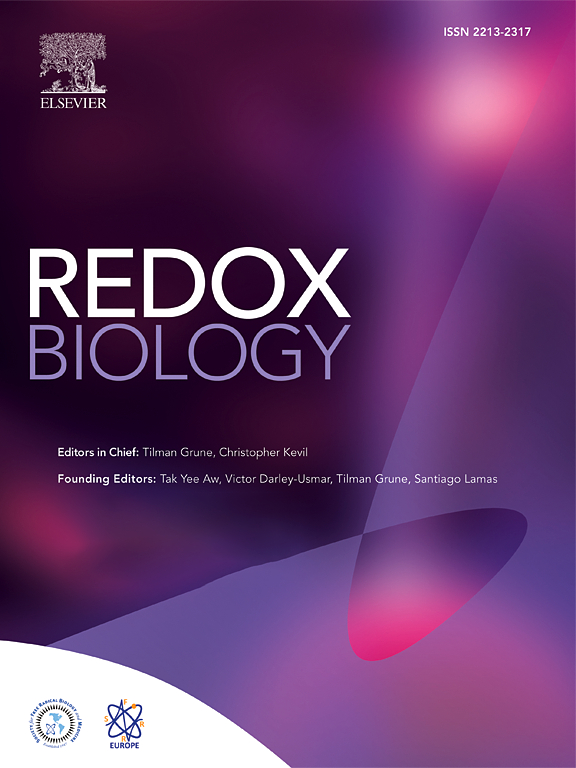Decoding Parkinson's Disease: The interplay of cell death pathways, oxidative stress, and therapeutic innovations
IF 11.9
1区 生物学
Q1 BIOCHEMISTRY & MOLECULAR BIOLOGY
引用次数: 0
Abstract
Parkinson's disease (PD), a complex neurodegenerative disorder characterized by selective loss of substantia nigra (SN) dopaminergic neurons, pathological aggregation of α-synuclein (α-syn), and chronic neuroinflammation, is fundamentally driven by redox imbalance and oxidative stress. Recent studies reveal that a dynamic interplay of programmed and non-programmed cell death mechanisms—amplified by oxidative damage—drives PD progression. Programmed cell death pathways include apoptosis (caspase-dependent mitochondrial/extrinsic pathways), necroptosis (eceptor-interacting serine/threonine-protein kinase 1 (RIPK1)/RIPK3/mixed lineage kinase domain-like protein (MLKL) axis), pyroptosis (NOD-like receptor thermal protein domain associated protein 3 (NLRP3) inflammasome/Gasdermin D (GSDMD)-mediated pore formation), PARthanatos (DNA damage-poly ADP-ribose polymerase (PARP-1)/apoptosis-inducing factor (AIF) cascade), ferroptosis (redox imbalance-driven lipid peroxidation/glutathione peroxidase 4 (GPX4) inactivation), disulfidptosis (disulfide stress from cystine metabolic collapse), and cuproptosis (mitochondrial lipoylated protein toxicity via copper-mediated oxidative damage), while non-programmed necrosis is triggered by energy collapse and calcium overload. Mitochondrial dysfunction, endoplasmic reticulum stress (ERS), and oxidative stress act as central redox hubs, integrating multiple death pathways through reactive oxygen species (ROS) bursts (O2·-, H2O2, ·OH), calcium dysregulation, and metabolic abnormalities, forming a self-amplifying vicious cycle. Non-neuronal cells (e.g., microglia and astrocytes) exacerbate neuronal redox damage by releasing pro-inflammatory cytokines (tumor necrosis factor-α (TNF-α), interleukin-1β (IL-1β)), dysregulating iron/copper metabolism (enhancing Fenton chemistry), and suppressing autophagic flux. Therapeutic strategies targeting redox-critical nodes include caspase/RIPK1 inhibition, GPX4 activators, autophagy modulators (rapamycin), acid β-glucocerebrosidase (GBA1) restoration, iron/copper chelators, and antioxidants (N-acetylcysteine) to restore glutathione homeostasis. Additionally, regulating glial polarization (triggering receptor expressed on myeloid cells 2 (TREM2) agonists) may disrupt inflammation-redox-death loops. Future challenges include deciphering spatiotemporal heterogeneity of cell death, developing multi-target redox therapies, and advancing biomarker-driven precision medicine (circulating free DNA (cfDNA), p-MLKL). Targeting redox dysregulation will guide breakthrough PD therapies.
解读帕金森病:细胞死亡途径、氧化应激和治疗创新的相互作用
帕金森病(PD)是一种复杂的神经退行性疾病,以黑质(SN)多巴胺能神经元选择性丧失、α-突触核蛋白(α-syn)的病理聚集和慢性神经炎症为特征,其根本原因是氧化还原失衡和氧化应激。最近的研究表明,程序性和非程序性细胞死亡机制的动态相互作用-被氧化损伤放大-驱动PD的进展。程序性细胞死亡途径包括凋亡(caspase依赖性线粒体/外源性途径)、坏死坏死(受体相互作用丝氨酸/苏氨酸蛋白激酶1 (RIPK1)/RIPK3/混合谱系激酶结构域样蛋白(MLKL)轴)、焦亡(nod样受体热蛋白结构域相关蛋白3 (NLRP3)炎症小体/Gasdermin D (GSDMD)介导的孔形成)、PARthanatos (DNA损伤-聚adp -核糖聚合酶(PARP-1)/凋亡诱导因子(AIF)级联)、铁下垂(氧化还原失衡驱动的脂质过氧化/谷胱甘肽过氧化物酶4 (GPX4)失活)、二硫下垂(胱氨酸代谢崩溃引起的二硫应激)和铜下垂(铜介导的氧化损伤引起的线粒体脂化蛋白毒性),而非程序性坏死则由能量崩溃和钙超载引发。线粒体功能障碍、内质网应激(ERS)和氧化应激作为中心氧化还原枢纽,通过活性氧(ROS)爆发(O2·-、H2O2、·OH)、钙调节失调和代谢异常整合多种死亡途径,形成自我放大的恶性循环。非神经元细胞(如小胶质细胞和星形胶质细胞)通过释放促炎细胞因子(肿瘤坏死因子-α (TNF-α)、白细胞介素-1β (IL-1β))、铁/铜代谢失调(增强芬顿化学)和抑制自噬通量加剧神经元氧化还原损伤。针对氧化还原关键节点的治疗策略包括caspase/RIPK1抑制、GPX4激活剂、自噬调节剂(雷帕霉素)、酸β-葡萄糖脑苷酶(GBA1)恢复、铁/铜螯合剂和抗氧化剂(n -乙酰半胱氨酸),以恢复谷胱甘肽的稳态。此外,调节神经胶质极化(骨髓细胞上表达的触发受体2 (TREM2)激动剂)可能会破坏炎症-氧化还原-死亡循环。未来的挑战包括破解细胞死亡的时空异质性,开发多靶点氧化还原疗法,以及推进生物标志物驱动的精准医学(循环游离DNA (cfDNA), p-MLKL)。靶向氧化还原失调将指导PD治疗的突破。
本文章由计算机程序翻译,如有差异,请以英文原文为准。
求助全文
约1分钟内获得全文
求助全文
来源期刊

Redox Biology
BIOCHEMISTRY & MOLECULAR BIOLOGY-
CiteScore
19.90
自引率
3.50%
发文量
318
审稿时长
25 days
期刊介绍:
Redox Biology is the official journal of the Society for Redox Biology and Medicine and the Society for Free Radical Research-Europe. It is also affiliated with the International Society for Free Radical Research (SFRRI). This journal serves as a platform for publishing pioneering research, innovative methods, and comprehensive review articles in the field of redox biology, encompassing both health and disease.
Redox Biology welcomes various forms of contributions, including research articles (short or full communications), methods, mini-reviews, and commentaries. Through its diverse range of published content, Redox Biology aims to foster advancements and insights in the understanding of redox biology and its implications.
 求助内容:
求助内容: 应助结果提醒方式:
应助结果提醒方式:


